Back then, hotel guests were only concerned about a place to rest their heads, and it was all about conformity. They liked knowing what to expect and not having to adjust.
But today, guests are looking for something new and exciting. Therefore, along with interior design, hotel exterior design has changed, too.
Guests now expect world-class amenities, comfort, and unique appeal with functionality. Setting the pace with distinctive exteriors and making a lasting impression on guests significantly impact customer experience and repeat business.
So, if you’re missing the curb appeal on guest perception with exceptional exterior designs, you might as well be turning customers away.
This calls for the best hotel exterior design ideas and a new approach to transform the guest experience and extend their stay.
In this blog, we will walk you through the 9 best well-thought-out exterior design ideas for hotels to help you make an impact and stand out in a competitive hospitality market.
1. Eye-Catching Entrance

An eye-catching entrance exterior design can set the tone for the entire guest experience. It gives the guests the first impression of the hotel and defines their expectations and perceptions.
A captivating hotel front design communicates warmth, instantly drawing guests in, welcoming them, and increasing hotel occupancy.
Consider these 4 best ideas to create a welcoming atmosphere for the guests.
- Grand Archways: These exterior design elements give a luxurious feel, becoming a focal point that captures guests’ attention on arrival.
- Porte-Cochères: Offer a sheltered drop-off area for guests, enhancing convenience and sophistication while providing a seamless exterior and interior transition.
- Impressive Landscaping: Surround the entrance with lush greenery, vibrant flowers, and trimmed gardens to create an inviting ambiance that immediately delights guests.
- Interactive Entry Features: Install interactive elements like touch-screen kiosks or motion-activated lighting effects that engage guests as they approach the entrance.
For example, the Atlantis Palm Dubai gives the most ultra-luxury feel with grand archways to welcome guests to a transcended experience.
Moreover, as guest demands evolve, hoteliers adapt to changing preferences and now position their entrance as a place for social gatherings rather than an entry alone.
2. Stunning Facade
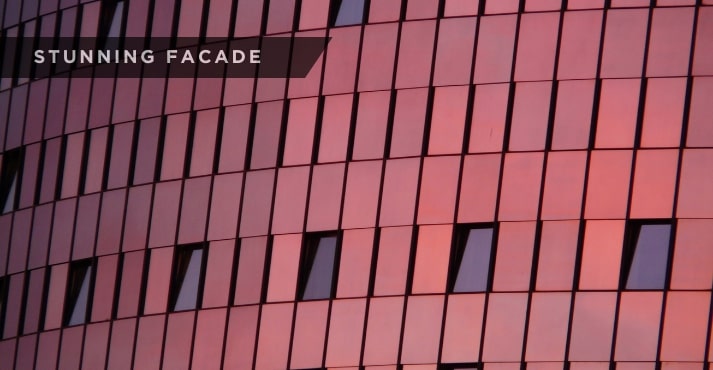
Every hotel building has a facade. A facade elevates the hotel’s aesthetic appeal and gives an unforgettable first impression to the guests. Unique architectural features like striking angles, asymmetrical designs, or intricate patterns create visual interest and make the facade look stunning.
Modern finishes such as sleek metal cladding or glass curtain walls add an extra edge, while artistic detailing such as murals, sculptures, or decorative lighting adds charm. Thoughtful use of materials, textures, and colors enhances the depth and dimension of the hotel’s exterior design.
Here are some of the most common materials that can be used to create stunning facades for a hotel exterior:
- Glass: Utilize glass panels or curtain walls to create a sleek and modern appearance, allowing natural light to pass through the interior spaces while offering connectivity with the surroundings.
- Stone: Add stone cladding or facades to depict timeless elegance and durability, adding texture and depth to the exterior while complementing the landscape.
- Fiber: Explore using innovative fiber-reinforced materials for lightweight and versatile applications, enabling unique shapes and patterns that enhance visual interest and architectural expression.
- Metal: Integrate metal facade to give a contemporary aesthetic flair, providing contrast while offering durability and low maintenance.
For example, the Wanda Reign Wuhan Hotel in China is an award-winning international architectural design.
The design of the luxury hotel facade is characterized by a compilation of 902 hexagonal modules, which create the effect of multiple windows as ‘eyes’ looking out over the city from the guest rooms.
Each hexagonal module has reflective aluminum and LED lighting, adding texture to the building at night.
Moreover, beyond the aesthetic value that facades add to the hotel exterior, they provide weather protection and secure the hotel against damage for many years.
3. Inviting Outdoor Spaces

Inviting outdoor spaces attracts hotel customers and offers a retreat from the hustle and bustle of daily life. The hotel’s outside design provides guests with opportunities for relaxation, socialization, and connection with nature.
With their intimate settings and lush greenery, Courtyards offer a tranquil escape where guests can unwind peacefully. Terraces provide panoramic views and al fresco dining experiences, inviting guests to enjoy delicious meals while enjoying the fresh air.
Garden areas offer a fresh feel with vibrant flowers, aromatic herbs, and soothing water features, enticing guests to meditate or enjoy quiet moments surrounded by natural beauty.
Here are some ideas to create an inviting outdoor space for your hotel:
- Comfortable Seating: Provide different seating options, such as cushioned lounge chairs, hammocks, and cozy benches, to accommodate different preferences and allow guests to sit comfortably.
- Fire Pits: Install fire pits or outdoor fireplaces to create a warm and inviting atmosphere, perfect for gatherings and storytelling under the stars, especially during cooler evenings.
- Water Features: Add elements of water features like fountains, ponds, or cascading waterfalls to create a sense of serenity.
- Lush Landscaping: Surround the outdoor space with lush greenery, colorful flowers, and native plants to create a natural ambiance.
- Al Fresco Dining Areas: Design dedicated dining areas with outdoor tables, umbrellas, and ambient lighting to allow guests to enjoy meals in the fresh air.
- Entertainment Zones: Incorporate entertainment options such as outdoor games like chess or cornhole, yoga decks, or outdoor movie screens to provide additional recreational activities.
- Shade Structures: Provide shaded areas with pergolas, umbrellas, or retractable awnings to offer relief from the sun and ensure guests can comfortably enjoy the outdoor space.
For example, The Oberoi Amarvilas, Agra, India, is a luxurious hotel with a stunning exterior design and stunning outdoor spaces, providing a comfortable and stylish seating area for guests to enjoy the breathtaking views of the Taj Mahal.
4. Creative Signage and Branding
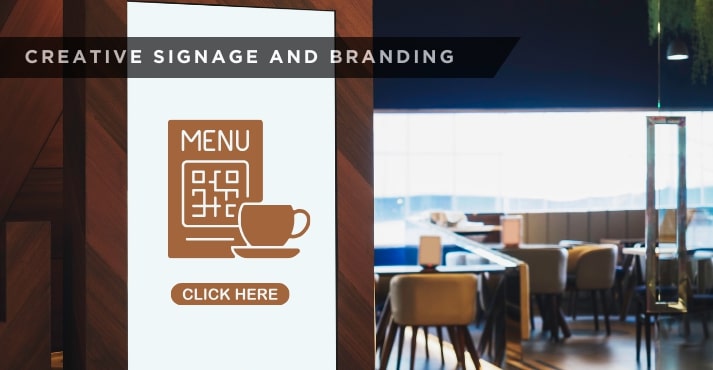
Creative signage and branding are essential elements in defining the perception of a hotel and attracting guests. They serve as the first point of contact, capture your guests’ attention, and keep them informed.
A well-designed sign helps guests locate the hotel and improves hotel operations. Consistent branding on signage with the right colors, fonts, and designs will evoke emotions in customers, reinforce hotel brand recognition, and establish credibility.
As a hotelier, it is essential to know that minor details in exterior design can help guests navigate your hotel and create a positive impact in the eyes of guests.
Here are ideas for creative signage and branding integration:
- Illuminated Signs: Use LED lights or backlighting to illuminate signage, making it stand out and visible even at night, creating a striking visual impact that attracts guests.
- Digital Displays: Add digital screens or displays to showcase content such as promotional videos, event schedules, or local attractions, providing real-time information and engaging guests.
- Unique Logo Designs: Create a distinctive logo that reflects the hotel’s identity and values, incorporating elements that establish a solid visual connection with guests and differentiate the hotel from competitors.
- Interactive Signage: Leverage interactive signage solutions such as touch-screen kiosks or QR code scanners that allow guests to access relevant information, maps, or special offers, enhancing convenience.
- Digital Menu Boards: Enhance your hotel’s dining experience with digital menu boards that showcase your culinary offerings, daily specials, and other relevant information.
- Directional Signage: Install clear directional signage throughout the property to guide guests to critical areas such as reception, dining, amenities, and parking, ensuring a stress-free experience.
For example, the New York Marriott Marquis hotel adds excitement with LED displays in their atrium walkway, showcasing stunning visuals such as videos and GIFs on each; the hotel has integrated real-time weather data to keep guests constantly updated.
5. Lighting Design
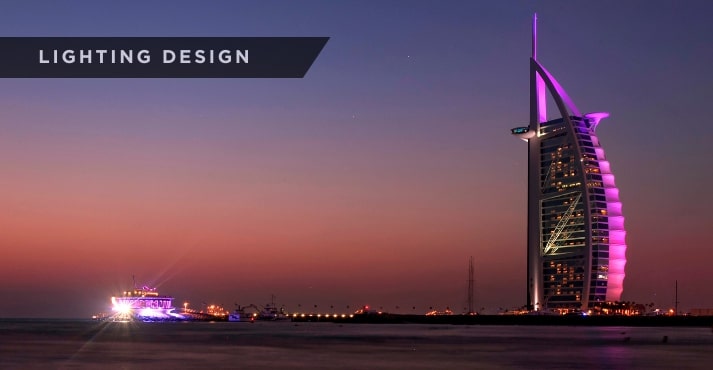
A well-lit hotel exterior is essential to make guests feel safe and comfortable. Exterior lighting enhances the aesthetic appeal of a hotel.
Thoughtfully placed lights can enhance architectural features, landscaping, and signage, creating a captivating visual experience that draws attention and enhances the overall experience of hotel guests.
If you have adequate hotel exterior lighting, you are less likely to have shadowy areas, giving guests a positive impression of your property. Modern hotel lighting that is stylish, eye-catching, and welcoming attracts guests and sets the mood for the guests.
Consider these 5 lighting design ideas to enhance hotel exterior design:
- Facade Lighting: These lights accentuate architectural details, creating depth and dimension while showcasing the building’s unique design elements.
- Pathway Lighting: Install low-level lights along pathways and walkways to guide guests safely to and from critical areas such as entrances, parking lots, and amenities, enhancing visibility and security.
- Accent Lighting: Use spotlights or uplights to highlight specific architectural features, landscaping elements, or signage, creating focal points and adding visual interest to the exterior design.
- Underwater Lighting: Incorporate underwater lighting in pools, fountains, or water features to create a mesmerizing ambiance in the outdoor space.
- Color-Changing Lighting: Integrate color-changing LED lights to create dynamic lighting effects that can be adjusted to match different occasions, seasons, or events, adding versatility and excitement to the hotel’s exterior design.
For example, the Burj Al Arab hotel building has an architectural lighting system with color-changing fixtures illuminating the tower’s impressive fabric “sail” facade. The new pure-white strobe lights with state-of-the-art LED technology ensure considerably lower maintenance costs and energy consumption.
6. Sustainable Design Features

Consumers’ growing awareness of sustainability in the hospitality industry has increased concern for hoteliers to ensure environmental responsibility at their establishments.
Hoteliers must incorporate sustainable design features that minimize the hotel’s ecological footprint and appeal to environmentally-conscious guests seeking eco-friendly accommodations.
From energy-efficient lighting and HVAC systems to water-saving fixtures and renewable materials, sustainable design practices help reduce resource consumption and waste generation while promoting a healthier, more sustainable future.
Follow these ideas for incorporating sustainable design features into your hotel exterior:
- Green Roofs: Install vegetated roofs to reduce heat absorption, improve insulation, mitigate stormwater runoff, and enhance biodiversity.
- Solar Panels: Integrate solar photovoltaic panels on rooftops or carports to harness renewable energy from the sun, powering hotel operations and reducing reliance on fossil fuels, lowering carbon emissions and operating costs.
- Native Landscaping: Utilize native plants in landscaping to minimize water usage, support local ecosystems, and reduce the need for chemical pesticides and fertilizers.
- Energy-Efficient Lighting: Replace traditional lighting fixtures with LED lights and sensors to reduce energy consumption, prolong bulb lifespan, and create a more comfortable and sustainable lighting system.
- Water Conservation Systems: Implement water-saving measures such as low-flow faucets, toilets, and showers, as well as greywater recycling systems, to minimize water usage and wastewater generation.
- Recycled Materials: Incorporate recycled and sustainable materials such as reclaimed wood, bamboo flooring, recycled glass, and recycled metal into construction and furnishings.
For example, Hyatt Regency Hotel, Amsterdam, is environmentally friendly and sustainable and the first hotel in Amsterdam to recycle its bottles into glassware. Hives for swallows & bats in our green exterior contribute positively to the ecosystem. It has vertical gardens with special lighting to stimulate photosynthesis.
7. Art Installations
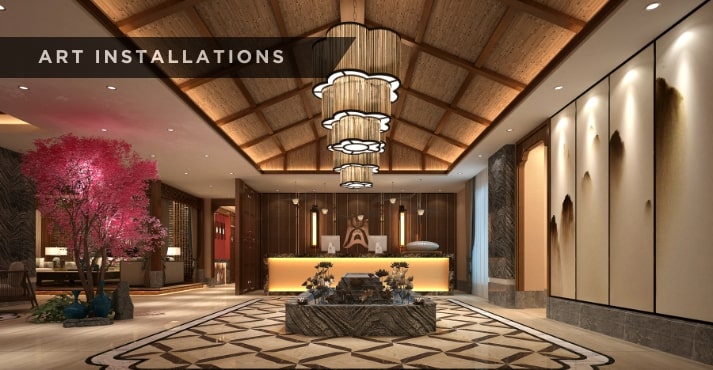
Art installations add beauty to exterior hotel design. Art installations engage guests and spark excitement, whether sculptures, murals, or interactive displays.
These creative expressions enhance the hotel’s aesthetic appeal and reflect its unique identity and cultural context. Hoteliers can showcase local artists or thematic works that resonate with hotel design.
Here are ideas to enhance the aesthetic of your hotel exterior:
- Sculptures: Place sculptures thoughtfully in the hotel’s exterior, selecting pieces that complement the architectural style and landscaping. Opt for sculptures of various sizes and materials, such as bronze, stone, or metal, to add visual interest and texture.
- Murals: Commission local artists to create vibrant murals on exterior walls or buildings. Facades depict scenes celebrating the destination’s culture, history, or natural beauty.
- Interactive Art Pieces: Install interactive art installations that invite guests to participate and engage actively with their surroundings.
Moreover, rotating art installations will keep the exterior design fresh and dynamic. These art installations serve as eye-catching focal points that enhance the aesthetic appeal of the hotel.
For example, Minos Beach Art is a beachfront hotel featuring sculptural elements inspired by marine life and art installations created during a series of symposia held at the hotel.
8. Seasonal Decorations and Themes

Regarding festive decorating, nobody gets more competitive than the biggest hotel chains in the world. The appearance of the exterior space will undoubtedly affect guests’ first impressions.
Seasonal decorations and themed displays create excitement, offering guests ever-changing experiences throughout the year.
From festive holiday decorations to seasonal floral arrangements, these decorative elements reflect each season, creating a warm and inviting ambiance that resonates with guests.
Whether it’s vibrant autumnal displays, whimsical winter wonderlands, or blooming spring gardens, seasonal decorations create a sense of nostalgia and celebration, enhancing the guest experience and inspiring them to return time and again.
Here are some great ideas for holiday decorations:
- Holiday Decorations: Transform the hotel with festive decor like twinkling lights, garlands, and themed ornaments, spreading holiday cheer and creating a magical ambiance for guests.
- Seasonal Landscaping: Add seasonal plants and flowers to the exterior, such as tulips in spring or pumpkins in fall, to delight guests with vibrant displays.
- Themed Events: Host themed events like summer barbecues, winter galas, or spring garden parties, offering guests unique experiences and opportunities for socializing.
Moreover, decorations and themes around local culture, events, and regional holidays can help hotels attract domestic tourists. This adds a personal touch and resonates with the community, creating a more meaningful and authentic festive atmosphere.
For example, hotel located in China can design their exterior space with red and gold paper lanterns and Chinese knots to give a local festive touch during the Red Lantern Festival.
Another excellent example of Rome Cavalieri, A Waldorf Astoria Resort, can be seen when hotel guests from around the world experience the holiday season with a program inspired by time-honored traditions.
Guests will receive a choice of restaurant options and activities within a warm and cozy atmosphere and indulge in the sweet holiday-inspired creations of the hotel’s executive pastry chef.
9. Accessibility and Universal Design
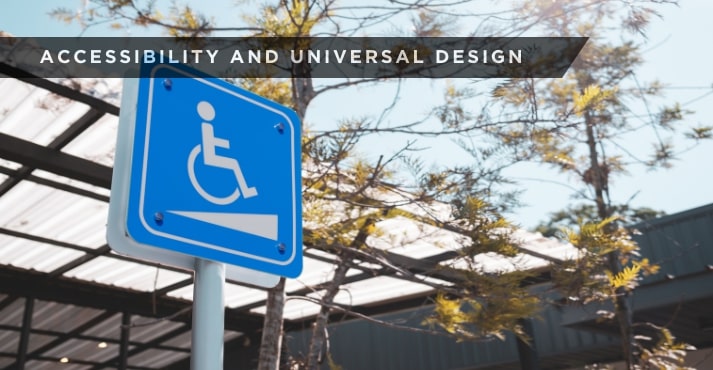
Accessibility in hotel exterior design ensures that all guests can fully enjoy their stay, regardless of their abilities.
Therefore, implementing universal design principles means creating spaces usable by people with diverse needs, including those with mobility impairments, visual or hearing impairments, or other disabilities.
Universal design principles care for bodies of all shapes, sizes, and abilities. It considers the individual’s comfort and keeps demands within desirable limits of body function. This includes ramps, handrails, curb cuts, and accessible parking spaces.
Hotels that prioritize accessibility demonstrate commitment to inclusivity and hospitality and lead to higher hotel customer loyalty, as the guests think about the place as an accommodating destination.
Consider these easy-to-integrate ideas for universal design features:
- Ramps: Install gently sloping ramps at entrances and exits to provide wheelchair access, ensuring smooth transitions between levels and eliminating barriers.
- Handrails: Add sturdy handrails along pathways and staircases to offer support and stability for guests to ensure safety and ease of navigation.
- Accessible Pathways: Create wide and level pathways with non-slip surfaces and clear signage to guide guests of all abilities and facilitate independent and comfortable movement.
For example, Keio Plaza Hotel Tokyo is known for its three universal Design rooms that allow guests of all ages and abilities to enjoy a comfortable stay. The hotel’s universal Design features include a wheelchair-friendly widened doorway, electric adjustable beds and lift chairs to assist guests in standing up, and wardrobes with lowered bar hangers. Moreover, the hotel also provides a voice navigation system by which a portable device will give auditory information on the room number and direction of elevators.
Conclusion
The exterior design of a hotel is essential in creating a memorable guest experience. From the grand entrance setting of the stay’s tone to the stunning facade that captivates people, every aspect of the exterior design attracts guests.
With distinctive architectural features, inviting outdoor spaces, and eye-catching signage, hotels can create a welcoming atmosphere that draws guests in and leaves a lasting impression.
Moreover, integrating sustainable design features, seasonal decorations, and universal design principles demonstrates a hotel’s commitment to the environment and adaptability to changing guest demands for sustainability.
Now that you know these 9 unique hotel exterior design ideas, you can create a point of differentiation in the competitive hospitality industry and ensure memorable experiences that keep guests coming back time and again.








